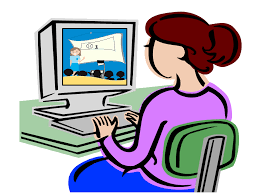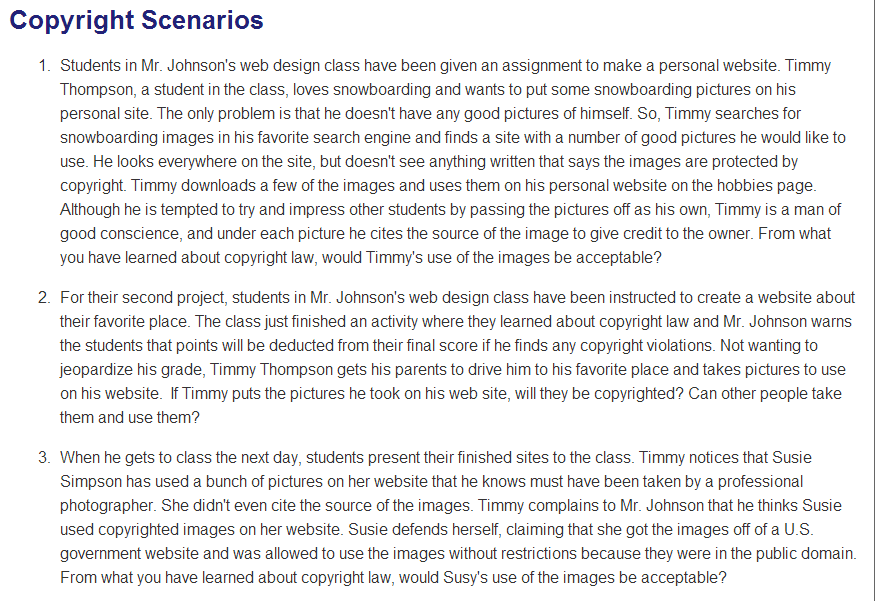
Question for ISTE Standard 4: How can I promote and model digital etiquette and responsible social interactions related to the use of technology and information? The articles I found the most compelling were Educational Leadership in an Online World: Connecting Students to Technology Responsibly, Safely, and Ethically, by M. Ribble and Navigate the digital rapids by J. Lindsay & V. Davis. I found the article by Dr. Ribble to accurately describe the needs that school leadership and staff must address. He presented Nine Elements for digital citizenship with class examples and implementation suggestions. I found a treasure trove of resources on his website, Digital Citizenship: Using Technology Appropriately, http://www.digitalcitizenship.net.
While digital literacy and responsibility can be addressed with many different activities it unfortunately is not at the forefront of technology implementation. An emphasis has been put on integrating our technology into the curriculum, and little or no instruction on teaching standards of conduct nor safety precautions. As pointed out in Digital Citizenship: Addressing Appropriate Technology Behavior, “Technology-infused teaching is becoming more commonplace every year. Technology in the classroom is becoming as transparent as the chalkboard and pencil… technology-infused teaching does not always include teaching about appropriate and inappropriate uses of technology” (Ribble, Bailey, & Ross).
In researching the Nine Elements I listened to an audio interview with Dr. Ribble on Digital Literacy. It has an administrator perspective, still it’s applicable to teachers as well.
Part one
Part two
It is not just students who need to be taught about rights and responsibilities, but staff and administration too. Misuse needs to be recognized by the teacher and administration where it can be addressed. Each instance can be used as guide on how to design instruction that will not allow students to think that misuse is acceptable. It is best said on Dr. Ribble’s website, “Digital citizenship is the norms of appropriate, responsible technology use. Too often we are seeing students as well as adults misusing and abusing technology but not sure what to do. The issue is more than what the users do not know but what is considered appropriate technology usage” (2014).
As noted in Navigate the Digital Rapids (2010), “educating students makes the internet a safer place” (Lindsay & Davis), for all uses of the internet as well as their personal safety. The Internet didn’t exist when I was in high School, and I remember my first Internet lesson during my first year teaching. Not having many computers or a real lab, I remained creative. Administration approved my request to travel to the nearby University I attended. The kids were excited and we spent 4-5 minutes for each page to load. We visited the White House website and heard socks meow. I couldn’t say what the other sites we visited were, they patiently waited for those pages to load also. Today if it doesn’t load in 10 seconds or less, we are gone.
Technology changes quickly and we must quickly adapt. Of the Nine Elements of responsible social interactions, Digital Etiquette and Digital Security address my question. Digital Etiquette defined as electronic standards of conduct or procedure, and Digital Security defined as self-protection which is electronic precautions to guarantee safety. As my learning circle colleague, Sara acknowledged, cell phone use is a big issue and can be address by either element. Tolerance for cell phones run the gambit, from not being allowed to being integrated into daily lessons. Promoting proper and mature use of cell phones is a lesson that should be taught to all students, not just those who will happen to have the “authorized” use in the classroom or school.
In several of my courses I use scenarios with my students to evaluate their understanding of the AUP (Authorized Use Policy) and also copyright. They work as a team and present their assessment of the situation, including any consequences that may result. I have had presentations where students do skits, use Prezi’ and PowerPoints, but I am beginning to see other possibilities. I was having difficulty seeing how I could use digital storytelling, but I think this would be a great opportunity. I am excited to try this with my students!

Lindsay, J., & Davis, V. (2010). Navigate the digital rapids. Learning and Leading with Technology, (March/April 2010), 13-15.
Ribble, M. & Miller, T.N. (2013). Educational Leadership in an Online World: Connecting Students to Technology Responsibly, Safely, and Ethically. Journal of Asynchronous Learning Networks, 17(1), 137-145.
Ribble, M. (2014). Welcome to the Digital Citizenship Website. Retrieved November 23, 2014, from http://www.digitalcitizenship.net/Home_Page.html
Ribble, M., Bailey, G., & Ross, T. (2004). Digital citizenship. Learning and Leading with Technology, 32(1), 6-12.
Hi Shannon,
I like that you pointed out that most technology misuse occurs because of the student’s lack of understanding and awareness. Many people do not know what is considered appropriate technology use. Digital etiquette should be taught to prevent possible issues.
It’s amazing how quickly technology does change. I remember when webpages took minutes to load. As teachers, we have to stay updated and familiar with new technological trends.
Thanks,
Callie
Thanks Callie,
I agree we must stay updated and familiar with new technology. I believe that school districts must begin to integrate this into training. They also need to understand that you can’t always just “know” how to use all technology.
As we focus on engagement this year, it would be helpful if technology was integrated in our trainings, modeling the way it could be used. Unfortunately, support in learning these new technologies will have to wait until administrators understand the uses of and integration techniques of technology.
Hi Shannon,
Your resource was incredibly helpful! Thanks for sharing your findings so clearly; I learned a lot from you this week (like usual).
I like that you addressed that staff and administration need to be taught about rights and responsibilities as well as the students. This is very true in my building. We have had a few technology training opportunities this year, but those have been focused on computer basics and Google docs. I can only recall one time in the last eight years when we discussed a topic like copyright during a staff meeting. It would be very beneficial to have a lesson on digital citizenship at one of our back to school meetings in August.
I love the sound of your AUP scenario lessons. It sounds like you have room for creativity and discussion. It would be interesting to see what students thought was appropriate and how they would choose to demonstrate their scenario. I’m intrigued!
Thanks!
Sara